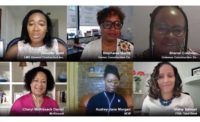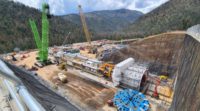Pay gaps between men and women are a problem in the AEC industry and beyond—and they are a sign of complex, systemic problems in companies. “It’s more of a symptom,” said Elizabeth Walgram, senior consultant in the compensation and career strategies practice at human resources consulting firm Segal.
The problem is acute in construction, however, with a workforce comprised of 90% men and 10% women, leaving the latter to fight harder for equity in pay and career advancement, said Sharon Hidalgo, firm vice president of new client acquisition.
Hidalgo and Walgram spoke about pay equity May 6 at the Groundbreaking Women in Construction virtual conference, presented by ENR in partnership with law firm Peckar & Abramson. Their keynote session comments were among others that addressed how to achieve equity and inclusion in industry office and jobsite workplaces.
In one study, female construction managers made 82 cents to every dollar made by a man in the same job—with salaries for women construction managers averaging about $71,000 to a man’s $82,000, Hidalgo said. Pay inequity tends to occur over time, with women being overlooked for promotions or higher salaries because companies often have internal biases built within their systems, Walgram said.
While men and women all start on equal footing at the bottom of the career ladder before age 30, by the time they reach 45, 37% of men, compared with 25% of women, are managers, and 8% of men, compared with 4% of women, are executives at a firm, according to Segal research.
Gaps in pay begin with a first job offer, Walgram said. Women either are not as comfortable negotiating for a higher salary, or don’t get more pay even when they ask. But, she added that if a woman is negotiating with another female, women are more likely to succeed in negotiating.
Women are also hampered because they are often tasked with volunteer jobs—things such as organizing an office party or working on committees that don’t advance pay or their career.
Saying no to such volunteer requests is one thing women can do to level the pay playing field. Women employees should identify female champions and mentors, and negotiate and accept stretch opportunities. For employers, Walgram suggested that companies must understand the culture around pay equity and “build urgency around the pay equity topic and the gender representation gap.”
Top Contractors Set Construction Inclusion Week
Five of the largest U.S. contractors—Turner Construction Co., DPR Construction, Gilbane Building Co., McCarthy Building Cos. and Mortenson—told the GWIC audience about the coalition they formed to build a zero-tolerance community against racism, hate, bias and harassment. Rodney Pope, Turner senior vice president, was “not surprised” that 54% of attendees responded in a poll that they personally had experienced hate or racism in the industry.
“It's not easy or quick to keep these behaviors from happening, but it's absolutely necessary to set the right culture.” —Rodney Pope, senior vice president, Turner Construction Corp.
“It’s not easy or quick to keep these behaviors from happening, but it’s absolutely necessary to set the right culture,” Pope said, comparing hate, harassment, racism, bias and discrimination to viruses. The firms agree that all incidents of hate and racism require action that can mean coaching for individuals willing to change, or in some cases, removal if they are not.
Stacee Barkley, DPR's diversity, equity and inclusion leader, announced one new remedy the coalition is developing—the first Construction Inclusion Week, set for Oct. 18-22. As they educate and celebrate, participants can “stand united in setting expectations and promoting consistent behavior,” she said, adding that the program is modeled on Safety Week in many ways.
Mortenson project manager Sydney Wittmier said that when a woman or person of color starts work on her site, she pulls them aside and says, “I hope you are treated fairly here, but in the event that you are not, please know that you have someone who is in your court—someone that will do something about any things they may happen to you.”
Young women of color shared experiences and challenges they had encountered in advancing construction careers.
They agreed that while the industry is becoming more diverse, there are still some preconceived notions they face. Nadene Taylor, associate at Beyer Blinder Belle Architects, noted that while prejudices exist, “showing that you know who you are and are just as good as them will dispel those lies.”
The best way to be an ally is to advocate for your colleagues, they agreed. “Don’t dismiss our complaints,” Alexandria Defaria, a Local 1 union plumber in Long Island City, N.Y., said. Taylor added that leaders “hearing from someone they trust that we did a good job” can mean a lot in terms of career growth.
Hephzibah Dadala, a third-year civil engineering student at California Polytechnic San Luis Obispo, who has worked at MNS Engineering, is a third-generation engineer. “My mom is an engineer, so it was normal for me to see women in engineering,” she said. But entering the field was an “eye opener” to the challenges of being a young woman of color. “I never questioned I belonged until I got there,” she said.
Digitized Diversity
Women technology experts in construction pointed to the power of digitization as a diversity booster, particularly in an industry “with a remarkable impact on the economy,” said Mona Affifi, associate CM professor at the University of Wisconsin-Stout and a research expert in industry tech adoption.
Noting that a key challenge for industry women has been jobsite “acceptability” and the long hours required, Nancy Novak, chief innovation officer of owner Compass Datacenters and a former contractor manager, said new technologies allow more offsite work that improves efficiency, reduces physical impacts on people and allows better oversight—for men as well as women. “We’ve really learned that with technologies like remote commissioning and digital twins, you can still have major project impact from a remote location,” she said.
Contending that construction is “second to last” among industry sectors in tech adoption, Cathy Hayes, vice president of industry software firm Hexagon PPM, pointed to the need for women experts “to bring to the table” technologies such as 4D and 5D BIM and advanced robotics “to improve how construction works and leverage existing knowledge with technology to show how to do something better. It’s important with firms’ thin margins today.”
Cara Wilcynski, customer success manager at Autodesk Construction Cloud, said that while superintendents “know the industry, I know the computer and how to pull up a model on an I-pad and access embedded data to better understand an installation process.”
The women experts agreed that prowess in technology has begun to level the playing field and change perceptions for industry women. Hayes said earlier in her career, “I was rarely asked for my opinion. Now I’m the expert at the table. It takes perseverance and passion, but if you bring good value, they’ll listen. That’s what you have to do to change the industry.”
Designing for Diversity
GWIC attendees also gained insights into emerging areas of diversity, equity and inclusion that have already begun to affect AEC professionals in designing and building facilities and infrastructure.
Ileana Rodriguez, principal at I Design Access, an international architecture design consultant, who is a paralympic swimmer, shared how inclusive design benefits everyone, not just the disabled. In a May 5 keynote, she said that inclusive design also improves a company’s bottom line and that making a design accessible does not necessarily mean it has to be ugly.
Rodriguez encouraged owners and designers to think of making a design accessible from the beginning, not just adding on those features later.
In GWIC’s closing keynote, Diana Mendes, newly named HNTB corporate president of infrastructure and mobility equity, noted that on a broader scale, project planning and execution will also will be required to focus on environmental justice that weighs equity impacts on communities.
“Infrastructure teams will need to be more inclusive as they engage with communities. Gone are the days of counting meeting attendees and transactional public involvement. We need to invite all people to the table, even those ... who don’t come willingly. And we must be accountable for taking action on their ideas.”
Mendes said the need for broadened public involvement spurred the firm’s work with the Iowa Dept. of Transportation to create the Public Involvement Management Application (PIMA) virtual platform that allows the agency to track thousands of stakeholder comments and highlight gaps in representation from different communities.
“Infrastructure teams will need to be more inclusive as they engage with communities. Gone are the days of counting meeting attendees and transactional public involvement. We need to invite all people to the table, even those who don't come willingly, and we must take action on their ideas.” —Diana Mendes, Corporate President, infrastructure and Mobility Equity, HNTB
“Equity must shape our mindset in how we create infrastructure to serve all people, not just those using facilities,” she said. “Investors know that such action builds value and stronger communities, the backbone of our country.”
Terming the emerging mindset the “co-creation economy,” Mendes said “we need to build our own model of co-creation for delivery of infrastructure that begins with really listening to employees, the community and others to create the best solutions possible.”
ESG pressure is one catalyst, as is the Biden administration.
Mendes pointed to what she termed its "transformational" Justice40 initiative that incorporates environmental justice into all federal agency missions—mandating that 40% of federal investment, including in infrastructure delivery, must address disproportionate impacts on underserved communities.
“This is not just a goal,” said Mendes. “The government will track it ... with impacts on funding, project priority and decision making.”
Mendes also urged the AEC industry to reframe its view of engaging with minority and women-owned small businesses and others traditionally labeled “disadvantaged,” not as “an obligation or requirement,” but as a way to “open eyes to different talents ... that may show an entirely new way" to do work, and even offer “competitive advantage.”
She said: “This is a time of great introspection and new conversations to change the way we do things."









Post a comment to this article
Report Abusive Comment